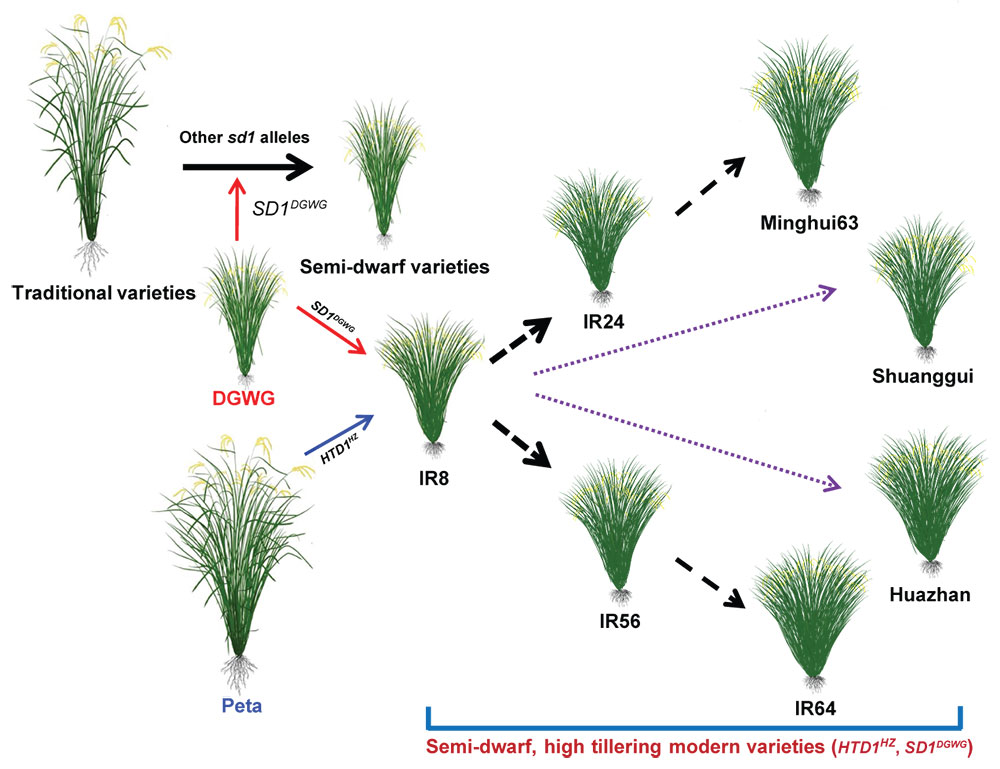







A strigolactones biosynthesis gene contributed to the Green Revolution in rice
April 9th, 2020
CNRRI scientists have identified a beneficial allele of the strigolactone biosynthesis gene, HIGH TILLERING AND DWARF 1 (HTD1HZ), which was found to be co-selected with the beneficial allele of Semidwarf 1 (SD1DGWG) by breeders during Green Revolution. By unveiling the underlying molecular mechanism of dwarf and high tillering, researchers have disclosed for the first time how HTD1, originally from the milestone variety of the rice Green Revolution, IR8, and its parent Peta, exists widely in most IR8 derived or other associated high tillering and dwarf indica varieties.
Genome resequencing analysis of RILs population derived from indica rice restorer Huazhan (HZ) and japonica cultivar Nekken 2 (NK2) reveals the mechanism regulating high tillering of Huazhan. It is recognized that HTD1HZ, a new allele of the strigolactones biosynthesis gene HTD1, contributes to dramatically increased tiller number without reducing seed setting rate. Further analysis shows that HTD1HZ is inherited from the high tillering cultivar Peta, parent of the “miracle rice” IR8 and that the gene regulates tiller number in a dominant way. These results explains why various hybird rice varieties derived from the elite rice variety Huazhan enjoys high tillering and stable yield, sharing large extension area in Southern China.
The research, entitled “A strigolactones biosynthesis gene contributed to the Green Revolution in rice”, was recently published online by Molecular Plant. It will give theoretical and practical insight to improving crop yield and adaptability by molecular designed breeding.
Supported by National Key Research and Development Program of China (Grant No. 2016YFD0101801), National Natural Science Foundation of China (Grant No. 91735304, 31971921, 31601285), Natural Science Foundation of Zhejiang Province of China (Grant No. LR20C130001), Shenzhen Peacock Plan (Grant No. KQTD2016113010482651) and the Agricultural Science and Technology Innovation Program of CAAS, the research was conducted through collaborative work with other researchers from Agricultural Genomics Institute at Shenzhen from CAAS (Chinese Academy of Agricultural Sciences) and Institute of Genetics and Developmental Biology from CAS (Chinese Academy of Sciences). More details can be found in the link below:
https://www.cell.com/molecular-plant/fulltext/S1674-2052(20)30071-X
· Study Reveals How the Clock Component OsLUX Regulates Rice Heading
· Scientists Further Unravelled the Underlying Mechanism of Heading Date Control in Rice
· Improving the efficiency of prime editing in rice
· A New Infection Mechanism of Ustilaginoidea virens is Revealed
· Scientists Further Reveal the Infection Mechanism of Ustilaginoidea virens
CNRRI Today
Copyright © 2014- China National Rice Research Institute